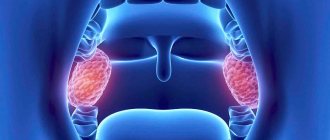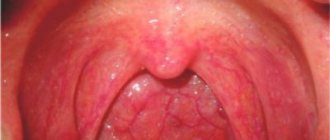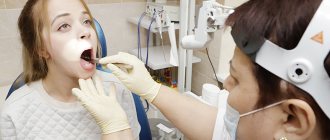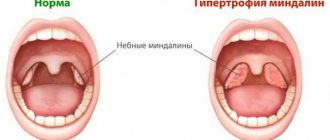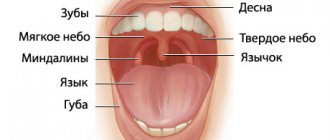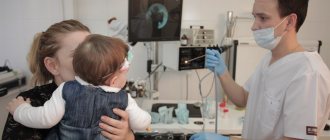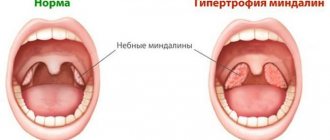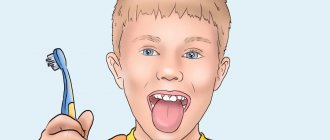The development of inflammatory pathologies of the palatine tonsils is often accompanied by the formation of purulent-caseous plugs in the recesses of accumulations of lymphoid tissue. As the disease progresses, the cheesy deposits thicken, enlarge and begin to cause discomfort. Rinsing the lacunae of the tonsils is the optimal method of conservative treatment that removes plugs
.
Causes and symptoms of the disease
Chronic inflammation of the tonsils can be caused by:
- untreated infectious diseases (most often it is a sore throat, so it is necessary to treat a sore throat in a timely and correct manner);
- the presence of other foci of inflammation in the body (for example, chronic sinusitis);
- diseases of the oral cavity (caries, stomatitis, periodontal disease);
- deviated nasal septum;
- heredity;
- reduced immunity;
- stress and nervous tension.
Any chronic disease is characterized by alternating stages of exacerbation and remission. During an exacerbation, the patient complains of pain, soreness, a feeling of a lump in the throat, as well as bad breath (which indicates the presence of purulent plugs in the lacunae of the tonsils). The body temperature rises to 37.5℃. It is very difficult to stay in this state for a long time. But you still need to study, work, lead a normal lifestyle. Only treatment by an otolaryngologist will help alleviate the patient’s condition and get rid of unpleasant symptoms.
Contraindications
It is also necessary to take into account a number of contraindications to such a procedure. These include:
- ENT diseases in the acute stage (including acute tonsillitis);
- influenza, ARVI and other viral diseases;
- acute form of tuberculosis;
- negative reaction of the body to ozone;
- malignant neoplasms of any location;
- hypertension 3 degrees;
- blood clotting disorder;
- first trimester and last month of pregnancy.
Remove or treat?
Among experienced patients, there are many stories from the series: “Previously, the problem was solved simply - you just need to remove the tonsils, and life will sparkle with bright colors.” Many patients purposefully come to an ENT doctor with a request to get rid of tonsils once and for all. However, many do not understand that by removing such an important organ of the immune system, a person is deprived of a natural barrier against infection. Yes, the problem of tonsillitis will disappear, but other diseases, for example, of the respiratory tract, will take their place. Bacteria and viruses will be able to freely enter the body, causing inflammation of other human organs and systems.
To remove tonsils according to indications, you need:
- often have a sore throat (more than four times a year);
- have a history of peritonsillar abscess;
- have poor rheumatic test scores;
- diagnose complications in your heart, kidneys or joints.
If there are no direct indications for removal, you need to contact an otolaryngologist to prescribe competent complex therapy, which will significantly increase the duration of remission and reduce the number of exacerbations.
One of the most effective procedures for treating tonsillitis, which avoids removal, is washing the palatine tonsils.
What are tonsils, structural features
The immune system consists of many components. They participate in the formation of the body’s immune response to pathogenic agents when attempting to introduce them. The tonsils are considered an important part of it. They are accumulations of lymphoid tissue. The tonsils are located in the mucous membrane lining the pharynx. Formations become the first filter on the path of infection into the body.
Together with other accumulations of lymphoid tissue, they form the pharyngeal ring. Tonsils have a complex structure. They are pierced by winding deep channels called crypts. Branching reaches the third or even fourth order. Their number is usually from 16 to 18 pieces. The epithelium covering the walls of the crypts is associated with lymphoid tissue over a large area.
These formations are most developed in the area of the upper pole of the tonsil. In their lumen, desquamated epithelial cells, food debris, leukocytes, and lymphocytes accumulate. Bacteria actively multiply in this environment. This structure promotes the development of chronic inflammatory processes inside the crypts.
Benefits of the procedure
There are two ways to rinse the tonsils: using a syringe or using the vacuum method using the Tonzillor apparatus. The ENT doctor decides how to rinse, based on the patient’s condition and his physiological characteristics.
The washing procedure has a number of undeniable advantages:
- persistent therapeutic effect (if you rinse your throat in courses, you can achieve long-term remission, and the symptoms of tonsillitis will not remind you of themselves for a long time);
- During the procedure, antiseptics and local antibacterial drugs are used, which act exclusively on the inflamed area, unlike conventional antibiotics taken orally;
- no allergic reactions;
- Children and pregnant women can wash their tonsils.
How often do rinses need to be done? For long-lasting results, otorhinolaryngologists recommend performing the procedure several times a year.
Friends! Timely and correct treatment will ensure you a speedy recovery!
Before washing your tonsils, you must stop eating at least an hour before visiting the doctor. After the session you need to abstain from food for a couple of hours.
Complex therapy for chronic tonsillitis usually includes ten rinsing sessions, which are carried out daily or every other day.
Contraindications to washing are: cancer, tuberculosis, acute infectious diseases, mental disorders, hypertension.
Regular rinsing allows you to avoid tonsillectomy (surgery to remove tonsils) and significantly increase the period of remission.
Classification
| Simple form Characteristic: the course of the disease with local symptoms, subjective complaints and objective signs of the disease, with frequent sore throats, and in other cases - without repeated sore throats (“anginless” chronic tonsillitis). | Toxicallergic form Characterized by: low-grade fever, phenomena of tonsillogenic intoxication, manifestations of tonsillocardiac syndrome. |
Rinsing the tonsils with a syringe
This method is the most common and accessible. It will be offered to you at the local clinic. The essence of the technique is as follows: an ENT doctor, using a needle-free syringe, injects an antiseptic drug into the lacunae of the tonsils, which, together with the purulent masses from the lacunae, is washed into the patient’s oral cavity. The patient spits the solution into a special tray, and the ENT doctor repeats the procedure. Upon completion, the tonsils are lubricated with Lugol's solution.
The disadvantage of the procedure is that it is not possible to thoroughly rinse the lacunae, since the openings in the tonsils are very narrow. This rinsing helps with minor purulent accumulations.
The manipulation should be carried out by an experienced ENT doctor. Inept movements can injure the walls of the tonsils, which will only worsen the patient’s condition.
Recently, in modern ENT clinics this technique is used less and less, mainly in cases where the patient has a pronounced gag reflex.
It is much more effective to rinse the tonsils using a vacuum method using the Tonsillor apparatus.
What methods are used
The purpose of flushing is to remove the purulent exudate accumulated in the tonsils. This is done using liquid or vacuum. Methods used:
- With a syringe. Rinsing with a syringe is one of the simplest and most accessible ways to clean the cavities of the lacunae. The slight pressure of a stream of antiseptic liquid, created by pressing the piston, breaks the plugs and removes accumulations of pus. After washing the solution, the person spits it out.
- Vacuum. The Tonzillor-MM device is used. The vacuum method is more effective. The plugs are crushed by ultrasound and “sucked out” using a vacuum. Using the method allows you to achieve complete cleansing of the lacunae and ensure deep penetration of drugs into the tonsil tissue. The use of a vacuum allows you to avoid the spread of infection to nearby mucous membranes.
- Cavitation and ultrasound. The technique is based on the creation of a micro-shock wave. When passing through the treatment solution, ultrasound forms small bubbles that burst inside the lacuna, creating a shock wave. Washing is performed with the UZOL device. A new technique that is almost twice as effective as other methods, but not all clinics have the equipment.
Hardware flushing is performed under local anesthesia. When using a syringe, no anesthesia is required. But if a person experiences pain and discomfort, then the tonsils are irrigated with an anesthetic.
Vacuum washing method
The vacuum method of rinsing using the Tonsillor apparatus is the most modern way to rinse the lacunae of the tonsils.
In simple terms, the nozzle of the Tonsillor device works on the principle of a vacuum cleaner. It is attached to the tonsil, the device creates negative pressure. The washing solution, passing through the lacunae of the tonsils, washes out their pathogenic contents, which, together with the waste solution, are sucked into a special cup of the nozzle. That is, the solution is used and passes through the tonsils only once, which confirms the sterility of the manipulation. Before washing, topical anesthesia of the tonsils is performed with lidocaine solution.
Despite the effectiveness of vacuum washing, this method is not without its drawbacks:
- it happens that the edges of the nozzle can injure the surface of the tonsil;
- The walls of the cup, where the washing solution that has passed through the tonsils is evacuated, is opaque, and the doctor cannot see whether the tonsils have been completely washed. As a result, the ENT doctor has to carry out additional procedures to certainly clear the lacunae.
A reasonable question arises: “Is washing the tonsils always associated with some risks?” No! There is another way to wash the tonsils - safe, effective and non-traumatic. This is the use of an improved Tonsillor attachment.
Rinsing with a modified Tonsillor nozzle
This method of washing will not be offered to you in any of the clinics in Moscow, except for the ENT Clinic of Doctor Zaitsev! An improved, modified attachment for the Tonsillor apparatus was developed by the founder of the ENT clinic, Vladimir Mikhailovich Zaitsev, together with his colleagues. The operating principle of the new nozzle is absolutely the same as that of the classic nozzle. The difference is in its structure:
- the improved “Tonsillor” nozzle creates greater negative pressure, due to which rinsing the tonsils is much more effective and of better quality;
- the edges of the nozzle in contact with the tonsils do not cause damage or microtrauma;
- The cup of the nozzle into which the washing solution with the purulent contents of the lacunae is sucked in is transparent, and the doctor immediately sees at what point the procedure can be stopped. Thus, the patient does not undergo unnecessary manipulations.
- The size of the nozzle allows washing even for children.
It is necessary to rinse the tonsils only with the participation of an otolaryngologist. We do not recommend self-medication!
In order to forget about the symptoms of chronic tonsillitis for a long time, it is necessary to undergo a full comprehensive course of treatment of chronic inflammation, including, in addition to rinsing, drug therapy and physiotherapeutic procedures. This is the only way to preserve the tonsils and achieve stable remission!
Treatment
There are two main methods of treatment: surgical and conservative.
The treatment method is determined by an otorhinolaryngologist, which depends on:
- forms of chronic inflammation;
- frequency of exacerbations;
- the presence or absence of beta-hemolytic streptococcus in the tonsils;
- effectiveness of previous therapy.
Conservative treatment method:
- Local antibiotic therapy
- Systemic antibiotic therapy (tablet or injection forms).
- Rinsing the lacunae of the tonsils and introducing antibacterial and anti-inflammatory drugs into them.
- Physiotherapeutic procedures:
- phonophoresis of drugs,
- ultraviolet radiation (UV),
- magnetic laser therapy (MILTA),
- vibroacoustic impact.

